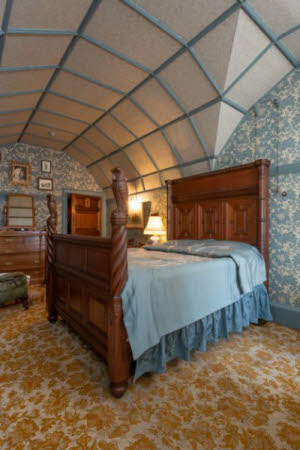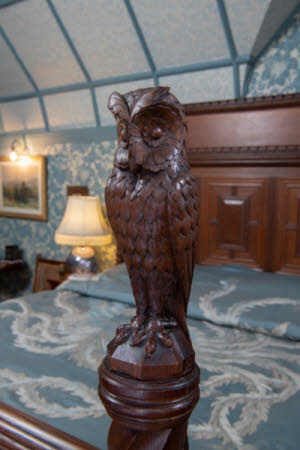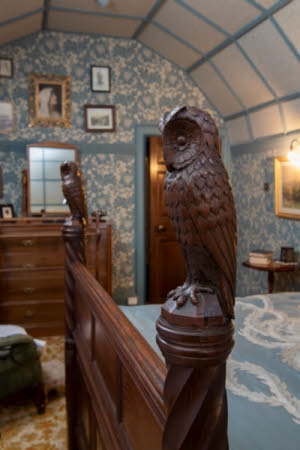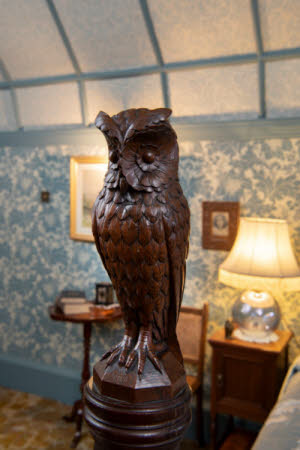Double bed
Richard Norman Shaw (Edinburgh 1831 - London 1912)
Category
Furniture
Date
circa 1875
Materials
Walnut, oak, textile, hair, feather
Measurements
195.5 cm (H); 210 cm (L); 168 cm (W)
Order this imageCollection
Cragside, Northumberland
NT 1227312.2.1
Summary
A walnut and oak double bed, English, circa 1875, designed by Richard Norman Shaw RA (1831-1912), and probably executed by W. H. Lascelles (1832-85), part of the so-called Owl Suite, also comprising NT 1227312.1, a half-tester bed and NT 1227321.3, a single bed. The headboard of three fielded panels within a moulded surround with mouldings at the cardinal points, beneath a plain frieze edged by dentil mouldings and all between engaged facetted columns with moulded capitals and knops. The footboard of two rows of two panels, the uppermost plain, the lower with applied fielded panels. Both the head- and footboard flanked by spirally-fluted and stop-chamfered posts each topped with a perching owl. The footposts also carved with a petalled flower.
Full description
This bed, and its two companions, were made around 1875 and installed in the suite of three rooms used by the Prince and Princess of Wales – the future Edward VII and Queen Alexandra - on a visit to Cragside in August 1884. The entertainments laid on for their visit were lavish – 10,000 lamps illuminated it and fireworks were launched from six balloons – and the amenities provided in their rooms were modern and up-to-date: hot and cold running water, a sunken bath, electric light, central heating and these Arts & Crafts beds. (1) This bed left Cragside and was re-discovered in 2006 a barn in Leicestershire bearing a plaque reading ‘Princess Alexandra occupied this bed when visiting Cragside’. In 2007, it was reinstated in the middle of the suite of three rooms. The largest, half-tester bed (NT 1227312.1) in the largest of the three rooms, was probably used by the Prince of Wales whilst (NT 1227312.3), the smallest of the three beds, occupied the smallest of the suite of three rooms and was probably used by a lady or gentleman-in-waiting. The beds are thought to have been designed by Richard Norman Shaw (1831-1912), the Scottish-born architect who rebuilt Cragside, the home of William Armstrong, 1st Baron Armstrong (1810-1900), in several phases between 1869 and 1885. Shaw’s furniture tended to fall into two groups – light and delicate – or, like these beds, masculine and sturdy. (2) The poppies and owls which decorate this bed both represent, or are intended as attributes of, ‘Sleep’ (owls are nocturnal creatures and poppies induce sleep) and were used by other designers for bedroom furniture and decoration. See, for instance, a design by John Dando Sedding for the decoration of a bedroom fireplace, which included owls, poppies, woody nightingale, moths and stag beetle, all symbolic of Night and Sleep. (3) The design may be related to a similar bed, designed in 1877 by George Faulkner Armitage (1849-1937), traditionally thought to have been made for Queen Victoria’s cancelled visit to open Manchester Town Hall, whose posts were also carved with owls. (4) Shaw and Lascelles displayed another bed with owl finials in 1877 in an annexe to the 1862 Exhibition Building run jointly with the Royal School of Art Needlework. (5) Some of the pieces were highly praised as pioneering in both the Building News and the Furniture Gazette. (2) William Henry Lascelles (1832-85) was a builder and pioneer in the use of concrete. He also designed and made furniture: in 1870, he registered his first patent, ‘an improved construction of Office Table’ where articles stored within the frame could be brought to hand without disturbing the writer. R. Norman Shaw used him to build Hopedene in Surrey (1873-5) and many other London houses. (6) (1) Cragside: Nothumberland (National Trust, 1982) (2) Andrew Saint, Richard Norman Shaw (Yale University Press, New Haven and London: Revised Edition, 2010), pp. 191-5, Fig. 169 (3) Margaret Richardson, Architects of the Arts & Crafts Movement (Trefoil Books, London: 1983), p. 38, Plate VI (4) Rosamond Allwood, ‘George Faulkner Armitage 1849-1937’ in Furniture History XXIII (1987), 67-87, p. 74, fn. 4. (5) 'Royal School of Needlework', in Survey of London: Volume 38, South Kensington Museums Area, ed. F H W Sheppard (London, 1975), pp. 231-232. British History Online http://www.british-history.ac.uk/survey-london/vol38/pp231-232 [accessed 15 June 2022]. quoting Building News 23 March 1877, pp. 285-6 (6) ‘Lascelles, William Henry’ in Dictionary of business biography: a biographical dictionary of business leaders active in Britain in the period 1860-1980 (1984), pp. 655 – 658
Provenance
Originally at Cragside for the Royal visit of 1884. Believed lost in intervening years and then discovered in dismantled state in Leicestershire barn approximately 2006. Authorised by Hugh Dixon to be collected and conserved (by John Scott of Hexham) in October 2006 and returned back to Cragside in March 2007 by same.
Makers and roles
Richard Norman Shaw (Edinburgh 1831 - London 1912), designer probably William Henry Lascelles (1832 - 1885), maker





